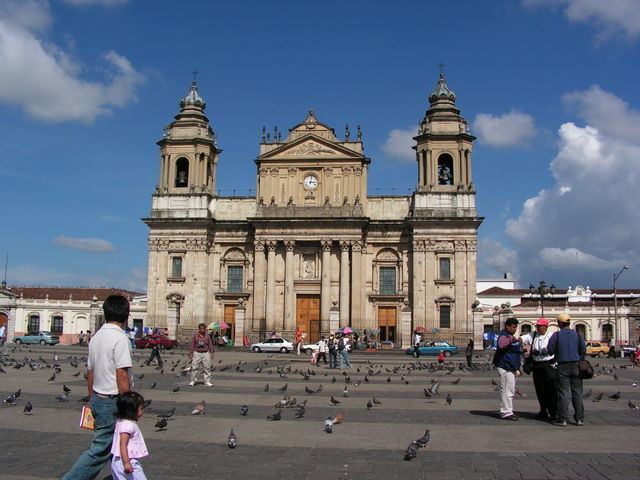 | ||
Catholicism was the official religion during the colonial era. Evangelical Protestantism (most Protestants are called Evangelicos in Latin America) and later Orthodoxy have increased in recent decades. About 40% of Guatemalans are Protestant, chiefly Evangelicals of different types, including Pentecostals. The Eastern Orthodox Church and Oriental Orthodoxy claim rapid growth, especially among the indigenous Maya peoples.
Contents
Religious freedom
Article 36 of Guatemala's constitution states that everyone has the right to practice their religion or belief, in public and in private. Guatemala has had no official religion since 1882.
Roman Catholic
Catholicism was the main religion during the colonial era. It is common for relevant Mayan practices to be incorporated into Catholic ceremonies and worship when they are sympathetic to the meaning of Catholic belief a phenomenon known as inculturation. The practice traditional Mayan religion is increasing as a result of the cultural protections established under the peace accords. The government has instituted a policy of providing altars at every Mayan ruin found in the country so that it is easier for traditional Maya to worship.
Protestantism
Current estimates of the primarily Evangelical Protestant population of Guatemala are around 40 percent, making it the most Protestant country in Latin America. Most of these Protestants are Pentecostals. The first Protestant missionary, Frederick Crowe, arrived in Guatemala in 1843, but Conservative President Rafael Carrera expelled him in 1845. Protestant missionaries re-entered the country in 1882 under the patronage of Liberal President Justo Rufino Barrios. These Northern Presbyterian missionaries opened the first permanent Protestant church in the country in Guatemala City, which still exists one block behind the presidential palace in zone 1 of Guatemala City.
Protestants remained a small portion of the population until the late-twentieth century, when various Protestant groups experienced a demographic boom that coincided with the increasing violence of the Guatemalan Civil War. Two Guatemalan heads of state, General Efraín Ríos Montt, who in 2013 was found guilty of genocide and crimes against humanity, and Jorge Serrano Elías, have been practicing Protestants. They are the only two Protestant heads of state in the history of Latin America. Large portions of the nations Mayan population are Protestants, especially in the northern highlands.
Orthodox Christianity
According to a Guatemalan Orthodox monastery, Orthodox Christianity arrived in Guatemala at the end of the 19th century and beginning of the 20th century with immigrants from Lebanon, Russia, and Greece. In the 1980s two Catholic women, Mother Ines and Mother Maria, converted to Orthodox Christianity and established a monastery. In 1992 they were received into the Antiochian Patriarchate and in 1995 the Catholic Apostolic Orthodox Antiochian Church in Guatemala was formally established. The state orphanage of Hogar Rafael Ayau, established in 1857, was privatized and transferred to their care in 1996.
In 2010 a religious group which had begun as a Catholic movement under a priest, Andrés de Jesús Girón (died 2014, also known as Andrew Giron), was received into the Orthodox Church by the Ecumenical Patriarchate of Constantinople and placed under the Greek Orthodox Metropolis of Mexico.
The Non-Chalcedonian Syriac Orthodox Church of Antioch, which is part of the Oriental Orthodox communion, received as many as 500,000 converts from a schismatic Catholic denomination in 2013. The Syriac Orthodox Patriarchal Vicariate of Guatemala is led by Archbishop Mor Yacoub Edward.
Both Eastern and Oriental Orthodox converts are almost largely made up of indigenous Mayans, a historically persecuted ethnic minority in Guatemala.
Latter Day Saints
The Church of Jesus Christ of Latter-day Saints in Guatemala claims over 255,000 members in 421 congregations in Guatemala which, if accurate, accounts for approximately 1.6% of Guatemala's estimated population in 2015. The first member of the LDS Church in Guatemala was baptized in 1948. Membership grew to a claimed 10,000 by 1966, and 18 years later, when the Guatemala City Temple was dedicated in 1984, membership had risen to 40,000.
By 1998 membership had grown to 164,000. A second temple, Quetzaltenango Guatemala Temple, was dedicated in December 2011.
However the church has also reported declining or stagnant numbers in the capital, Guatemala City.
Others
There are also small communities of Buddhists at around 9,000 to 12,000, Jews estimated between 1,200 and 2,000, Muslims at 1,200 and members of other faiths.
Atheism
Estimations of 2000 reveals that there was a significant percent of atheists or people with no religion.
Being "non-religious" in Guatemala can refer to atheism, adherence to no specific religion, or agnosticism. However, there are high percentages of confidence in the church and religious practice. Officially the country has had no state religion since 1882. According to a national poll in 2000, approximately 18 percent of Guatemalans are not religious, the highest figure in Latin America, just behind El Salvador and Uruguay.
